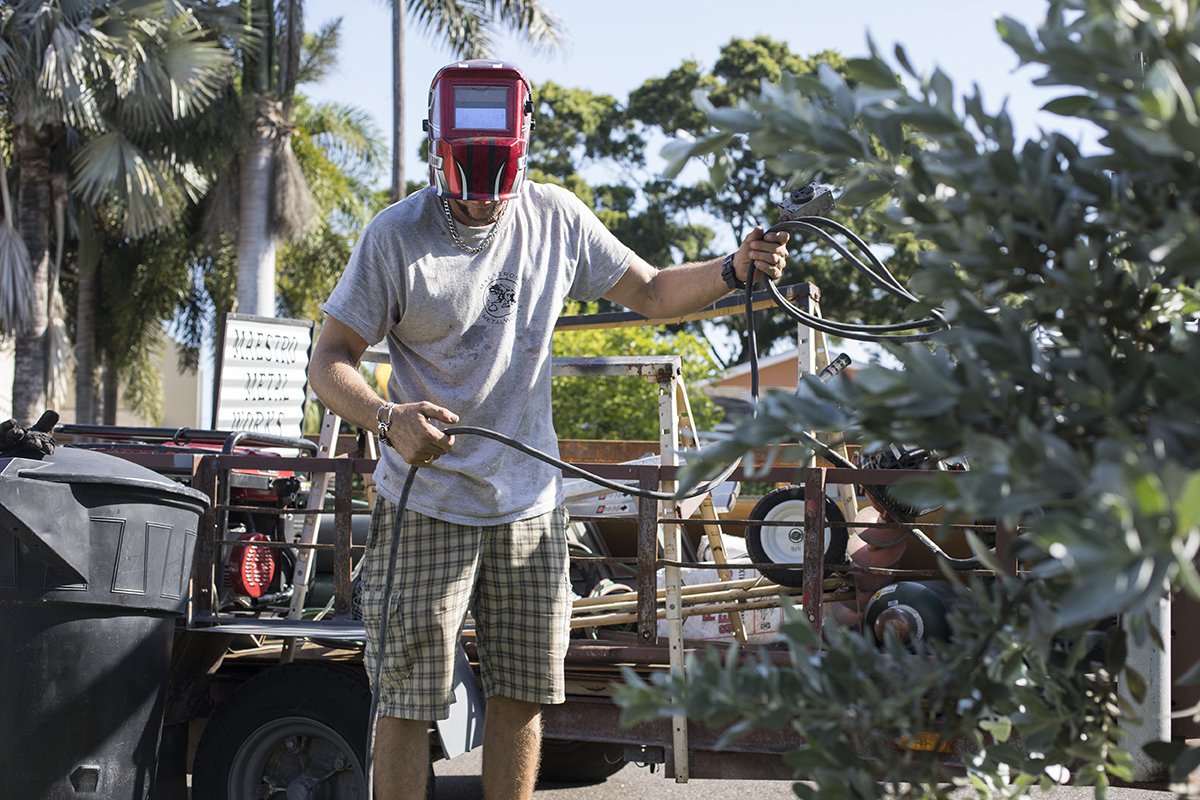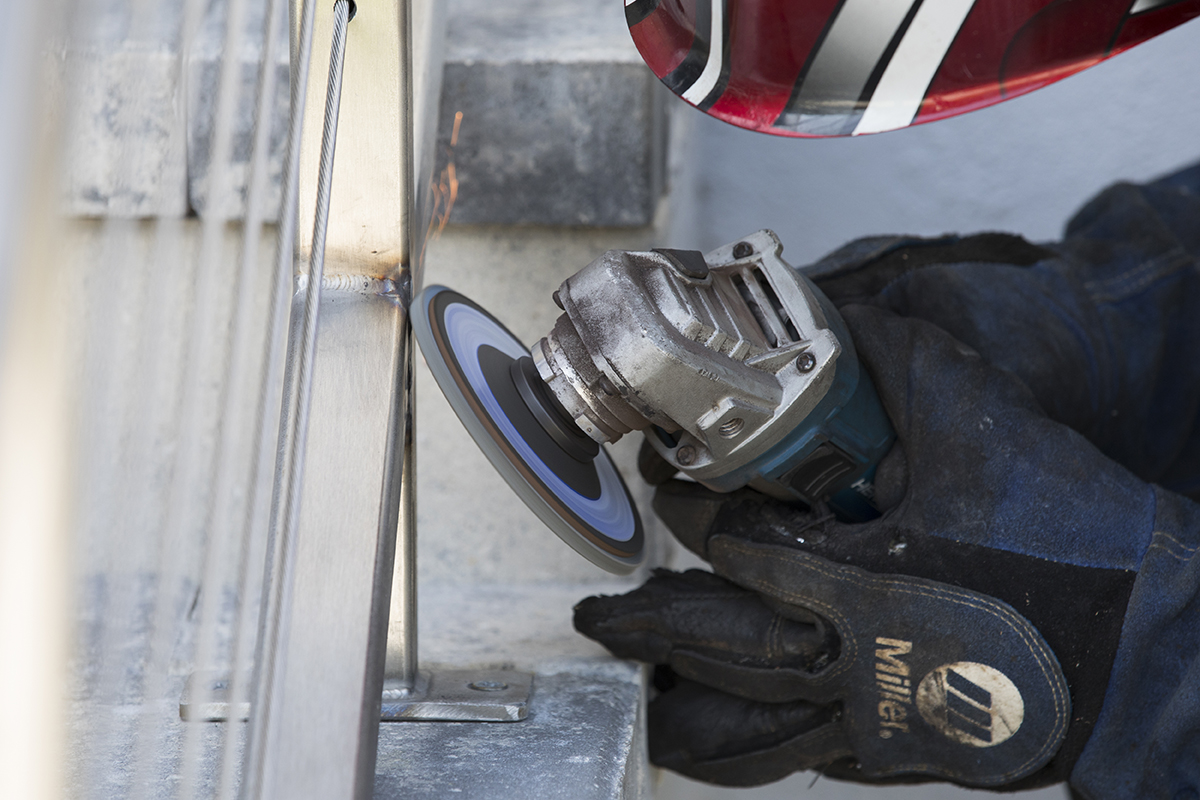How This Guy Forged Business and Art Into a Welding Career and a Company

Drew Danecki arrives at a job wearing shorts and a T-shirt, looking a lot more relaxed than Jennifer Beals’ hard-edged character in the ’80s movie “Flashdance”. It isn’t until he dons thick, scorched gloves reaching up to his elbows and a high-tech red helmet reminiscent of a Power Ranger that you realize his version of welding is just as rough as its big-screen portrayal.
The 40-year-old resident of St. Petersburg, Florida, is one of nearly 405,000 welders in the United States, a number that is expected to grow 6% through 2026, according to the U.S. Bureau of Labor Statistics. He has spent 20 years in the business, twisting, bending and shaping metal into his artistic vision.
Lugging tools from his trailer to the front yard of a private home where he’s finishing the front step’s railing, Danecki nonchalantly lists injuries he has sustained, including cuts, burns, pulled muscles, back injuries and something called flash burn, which sounds so much less fun than the movie.
“If you’re not wearing a welding hood, it’s pretty much like you’re looking straight into the sun, and it burns your cornea,” explains Danecki, who has experienced the condition himself. He describes it as the feeling of sand pouring from his eyes. “It takes about 10 to 12 hours — pretty much a good night’s rest — and then you’ll wake up in the morning, and you’ll still feel kind of sore.
“But you’ll recuperate, and you know it’s time to get back to work.”
Yep, just another day of burning your cornea.
“Protective gear is essential,” emphasizes Danecki, who says he also wears prescription UV contacts to further shield his eyes. “But intricate work sometimes requires you to remove [the gear].”
Also, working in the hot Florida sun requires you to decide which is more likely — an injury from your equipment or heat stroke from wearing one of those heavy welding suits.
As he grinds down stainless steel railing joints to a smooth finish, Danecki doesn’t seem phased by the spraying sparks. He explains that, due to the direction of the disc’s rotation, the sparks are unlikely to land on us.
Nevertheless, I’ll still stand over there. Waaay over there.
Welding: Art vs. Function

Danecki’s projects range from industrial work to fine art, but he says he considers himself foremost an artist.
And just like an artist, he has a passion for his medium.
“Once you get into steel, that’s kind of your life,” says Danecki, who holds a bachelor’s degree in business administration with an art minor from Saint Leo University in Florida. “That’s what you breathe every single day.”
He estimates that a quarter of his work is fine art sculptures, creating everything from tarpon fish to violins — a favorite since he plays the instrument. The violin is also the origin for the name of his business, Maestro Metalworks, which he launched in 2013.
The rest of Danecki’s projects are functional pieces, like staircase railings, signs, fences and frameworks, which he still describes in artistic terms, explaining each piece’s scrollwork designs and intricate detailing.
All in a Day’s (or Night’s) Work

When working on projects for places that operate in the daylight, Danecki adjusts his work schedule to meet the client’s needs.
For a job creating stainless steel drink rails and bar accents for the Disney Springs entertainment complex, Danecki says he arrived in the middle of the night to avoid tourists witnessing the work that goes into the Happiest Place on Earth.
“From 2 a.m., you’re on a ladder on top of the bar putting these pieces in,” says Danecki. “You know you have a deadline before the next morning.”
At another job for Raymond James stadium, home of the Tampa Bay Buccaneers, Danecki says he had to coordinate with the schedules of other tradespeople as they completed their parts of the project. He arrived around midnight to start his work, which he did on a scissor lift that elevated him 50 feet in the air.
“You have this big, huge piece of 6-by-6 [square], and you’re just suspended in the air,” says Danecki, describing the large powder-coated aluminum pieces he was installing above a football sculpture. “It’s shaking back and forth a foot at a time.
“It was scary.”
Welding as a Career

While the tech industry gets most of the attention, the growth in welding shows that there is still a demand for highly skilled tradespeople in the U.S.
And working as a welder pays pretty well.
The median annual wage is $40,240 ($19.35 an hour), according to the U.S. Bureau of Labor Statistics — greater than the U.S. median of $37,690 in May 2017.
Danecki says he earns approximately $1,000 to $2,200 for stainless steel pieces like business signage, while railings can run about $100 to $800 per foot, depending on the type of metal used and the intricacy of the design.
He says that he could make substantially more money if he was willing to take his trade on the road — or the water.
“The welders offshore and with the oil industry — they’re way up there,” says Danecki, who’s worked a few offshore gigs himself after completing additional certifications in 2014 through Falck Safety Services. “It turned out there was more work on land, for me, than to be gone for three, four, five, six weeks at a time.”
Forging Your Career in Welding

Wondering if a career in welding could be for you?
Technical schools across the country offer welding programs and certifications that cover safety procedures, manufacturing processes and various types of welding — there are different methods based on metal type, use and design.
Danecki suggests that if you’re interested but not sure you want to make the investment just yet, you can try your hand at welding via demonstrations and classes at art galleries that focus on metal art.
Even considering all the work involved with operating his own business, Danecki says he feels fortunate that he gets to do something he truly enjoys.
“It’s long hours,” Danecki says. “But if you love something, you don’t feel like you’re working a day in your life.”
Tiffany Wendeln Connors is a staff writer at The Penny Hoarder. Data Journalist Alex Mahadevan contributed to this story.

















